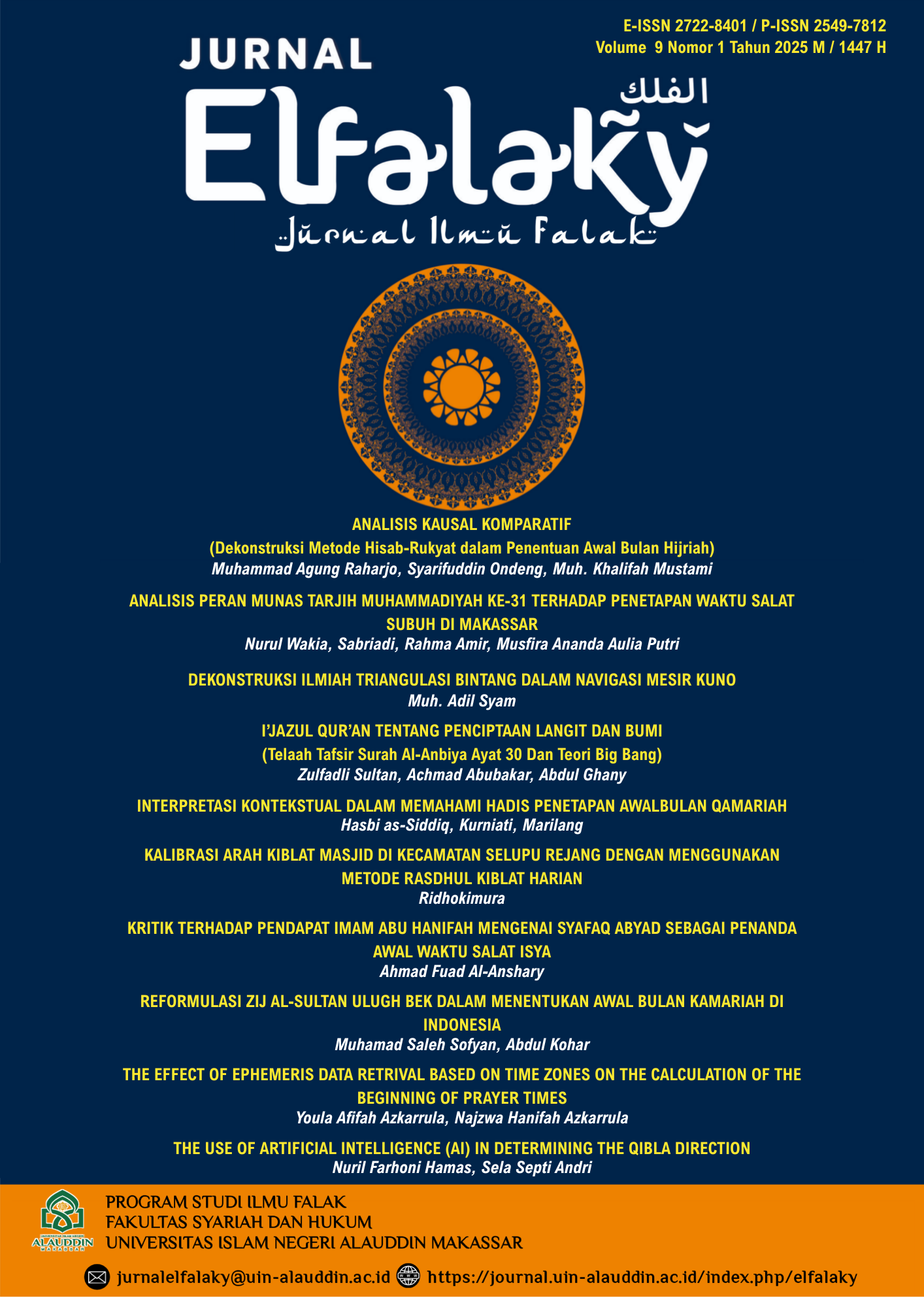THE EFFECT OF EPHEMERIS DATA RETRIVAL BASED ON TIME ZONES ON THE CALCULATION OF THE BEGINNING OF PRAYER TIMES
DOI:
https://doi.org/10.24252/ifk.v9i1.51969Keywords:
Ephemeris, Time Zone, , Sun’s Declination, Equation of Time, Prayer TimesAbstract
Five-time praying is valid if someone do the action when it has entered its time. The determination of prayer times need data from Ephemeris which is based on the sun’s motion. Here, the calculation needs sun’s declination and equation of time. Then how if someone do an error in taking Ephemeris data to calculate the time prayer. Should it affect the result. This research also examines how was the effect of prayer time using the taqribi sun’s motion in old books or kitab falak kuno. This article is library research using qualitative data presentation method. This research departs from the question that whether the difference in time zones will essentially affect the results of the calculation of the beginning of prayer time. The focus of this research is implied in whole globe of Earth by choosing four loci from China. This is due to the large area of China but using one type of time zone. From the calculation, the result is the ephemeris data retrieval errors in this calculation do not have a significant impact. There are three reasons why it is not that significant. First, when the Ephemeris data is calculated with trigonometric variables, it will produce smaller data than before. Second, Muslim only need the hour and minute not until the second. Third, there is an addition time to prayer times called ihtiyat or prudence.
References
Amirah, Nur. “Analisis Penentuan Waktu-Waktu Haram Salat Di Sungguminasa Kecamatan Somba Opu Dalam Perspektif Ilmu Falak.” HISABUNA: Jurnal Ilmu Falak 1, no. 2 (2020): 43. https://doi.org/https://doi.org/10.24252/hisabuna.v1i2.14953.
Ardliansyah, Moelki Fahmi. “IMPLEMENTASI TITIK KOORDINAT TENGAH KABUPATEN ATAU KOTA DALAM PERHITUNGAN JADWAL WAKTU SALAT.” Al-Ahkam, 2017. https://doi.org/10.21580/ahkam.2017.27.2.1981.
Azkarrula, Youla Afifah, and Sartika. “An Analytical Evaluation of Fiqh and Science Perspective Concerning Hajj: Tarwiyah Dan Arafat.” Al Qalam 39, no. 1 (2022): 40–54. https://doi.org/10.32678/alqalam.v39i1.
Herdyanto, Abraham. “8 Sejarah Zona Waktu, Dari Internasional Sampai Ke Indonesia.” IDN Times, 2021. https://www.idntimes.com/science/discovery/abraham-herdyanto/sejarah-zona-waktu-internasional-dan-indonesia?page=all.
Inuth. “Here’s Why Sandford Fleming Came up with the Idea of Standard Time Zones,” 2017. https://www.inuth.com/trends/science/heres-why-sandford-fleming-came-up-with-the-idea-of-standard-time-zones/.
Izzuddin, Ahmad. Ilmu Falak Praktik. Semarang: PT Rizki Putra, 2012.
Man, Saadan, Mohd Saiful Anwar Mohd Nawawi, Raihana Abdul Wahab, and Nurul Huda Ahmad Zaki, eds. Dimensi Penyelidikan Astronomi Islam. Kuala Lumpur: Universiti Malaya, 2013.
PULU, SRI RAHMADANI PULU. “Analisis Posisi Astronomis (Lintang Dan Bujur) Terhadap Perbedaan Awal Waktu Shalat Di Provinsi Maluku.” JURNAL PENDIDIKAN MIPA, 2022. https://doi.org/10.37630/jpm.v12i1.540.
Rahmi, Nailur. “Penyatuan Zona Waktu Dan Pengaruhnya Terhadap Penetapan Awal Waktu Shalat.” Juris 13, no. 1 (2014): 75–83.
Rahmi, Nailur, and Irma Suriani. “Zona Waktu Dan Implikasinya Terhadap Penetapan Awal Waktu Shalat Pengaruh Zona Waktu Terhadap Penetapan Awal Waktu Shalat.” PROCEEDING IAIN Batusangkar, 2020.
Riza Afrian Mustaqim. “RELEVANSI JADWAL WAKTU SALAT SEPANJANG MASA.” Jurnal Alwatzikhoebillah : Kajian Islam, Pendidikan, Ekonomi, Humaniora, 2020. https://doi.org/10.37567/alwatzikhoebillah.v6i2.282.
Rojak, Encep Abdul, Amrullah Hayatudin, and Muhammad Yunus. “KOREKSI KETINGGIAN TEMPAT TERHADAP FIKIH WAKTU SALAT: Analisis Jadwal Waktu Sholat Kota Bandung.” Al-Ahkam, 2017. https://doi.org/10.21580/ahkam.2017.27.2.1858.
Rosad, Safiq, Anton Yudhana, and Abdul Fadlil. “Jadwal Sholat Digital Menggunakan Metode Ephemeris Berdasarkan Titik Koordinat Smartphone.” IT JOURNAL RESEARCH AND DEVELOPMENT, 2019. https://doi.org/10.25299/itjrd.2019.vol3(2).2285.
Sahrani, Nurul, Rasyawan Syarif, and Rahmatiah HL. “Pengaruh Variabilitas Gerak Semu Matahari Terhadap Perubahan Waktu Salat Diberbagai Garis Lintang Perspektif Ilmu Falak.” HISABUNA: Jurnal Ilmu Falak 5, no. 1 (2024): 56–79. https://doi.org/https://doi.org/10.24252/hisabuna.v5i1.48051.
Statistics, Berau of Transportation. “History of Time Zones.” United States Department of Transportation, 2021. https://www.bts.gov/geospatial/time-zones.
Sudibyo, Muh. Ma’rufin. Sang Nabi Pun Berputar. Solo: Tinta Medina, 2011.









